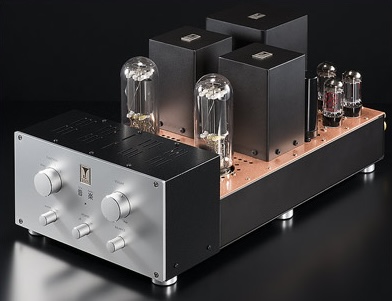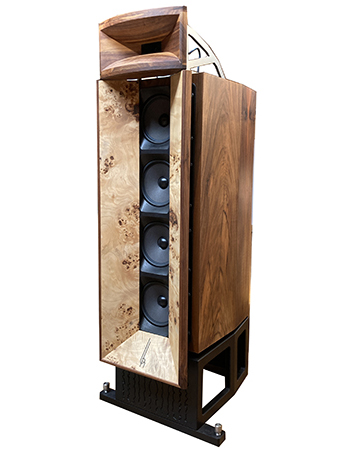Mature sound, timeless design, and the slow reveal of greatness.

Background
In 1989, Hiroyasu Kondo introduced his all-silver single-ended triode (SET) amplifier to the world. Since then, the ONGAKU has arguably become one of the most famous amplifiers ever made and is still in production today.
In 1992, Kondo-san published an article in Sound Practices magazine, explaining the ideas behind his design. That article even included the schematic for the ONGAKU.
Over the years, the ONGAKU has undergone some component changes while keeping the original design more or less intact. One of the most notable changes involves the transformers. When the famous Japanese transformer manufacturer Tango went out of business, Kondo began winding their transformers in-house. Most of the other components (capacitors, resistors, etc.) have also been updated with more modern versions.
Roughly two years ago, I struck a very tempting deal and acquired a fairly recent version of the ONGAKU brand new. As a seasoned audiophile, this was a dream come true.
First Impressions
My first impression was a disaster. I clearly remember the moment we hooked up the ONGAKU and started listening to it. The sound was unbalanced, immature, tense — like a brick wall: no depth, no cohesion, no nothing. Literally, my panic attack kicked in. My brain started listing all the possible negative things at a speed I couldn’t even keep up with.
After a while, I took a deep breath, calmed myself down, and started repeating to myself: the amplifier and all the tubes are new — let them burn in for at least a couple of hours before listening critically. I clicked on a random playlist, shut the door to my listening room, and left.
After a couple of hours, I came back to the room for a second time. When I opened the door, even before sitting in the sweet spot, the sound had changed so drastically that I had the biggest hi-fi relief of my life. Although this wasn’t the first or last time I’d experienced a brand-new component sounding terrible out of the box, it was definitely the most high-profile one.
Over the next hours, days, and weeks, the magic of the ONGAKU unfolded right in front of me. If you can manage to shake off the initial panic, it’s a wonderful journey to experience a component’s burn-in and maturation over time.
The Sound
First and foremost, the ONGAKU’s sound is far from the stereotypical tube amplifier sound, while still retaining all the strengths of a SET amplifier. And yes, I’m aware this has been said about many modern tube amps — but the ONGAKU is in a different league than most.
The ONGAKU truly is a high-end amplifier. It excels at every audiophile parameter you can imagine. It presents an incredible soundstage with pinpoint imaging and separation. The soundstage it creates is one of the most believable I’ve ever experienced. The ONGAKU is a very dynamic amplifier — both micro and macro dynamics are splendid. Tonal balance and timbre are also nearly perfect. You can experience the full harmonic textures and richness of a wooden-bodied instrument like a violin, cello, or double bass. If you mostly listen to acoustic instruments, like I do, once you hear this amplifier, you’ll immediately understand what I mean.
However, what makes the ONGAKU legendary is not these features alone, but the balance between them. The sound is far from the “dealer sound” you often encounter during demos, which can be very impressive and striking for the first 5–10 minutes. The ONGAKU never overemphasizes anything — the sound is not striking or in-your-face. Treble is silky smooth with texture and harmonics, the midrange is very musical and fluid, and the bass is fast and articulated with texture and detail. The more time you spend with this amplifier, the more layers of sound you discover.
If you are into wines, you know that what makes a wine great and sought after is its balance. A good, mature wine is complex in flavor, rounded, and layered. That’s also how I would describe the sound of the ONGAKU.
The Tubes
My copy of the ONGAKU came with 4 × Gold Lion GZ34s, 2 × Electro-Harmonix 6072s, 2 × Philips JAN 5687s, and 2 × PSVANE 211s. With stock tubes, the ONGAKU sounds good. However, to reach its full potential, you need to replace these tubes with better ones. In my experience, those better ones are always NOS, and some can be very expensive. Always factor in the cost of tubes when budgeting for a tube amplifier.
PSVANE 211s
The stock 211 tubes that came with the ONGAKU are made by PSVANE specifically for Kondo. These are not off-the-shelf tubes; they are Kondo-branded.
They’re modern-sounding, good tubes. If you prefer a dynamic and contemporary tube sound, you don’t need to change them.
I replaced mine with 1942 JAN GE tubes. The GEs are less dynamic than the stock ones — but in a good way. Their midrange fluidity is incredible, the treble is smooth, and the bass is nicely controlled and detailed. GEs are much more forgiving, especially for sub-par recordings.
Electro-Harmonix 6072s
These tubes are my main criticism of Kondo electronics. Almost every Kondo component uses 6072s, and the EH versions are mediocre at best. I really struggle to understand why Kondo continues to ship their gear with them.
In the ONGAKU, they’re used in the input stage in an SRPP configuration and have a huge impact on the sound.
They sound grainy. The treble is harsh and lacks harmonic richness. The midrange is stiff. The overall character is not musical.
I strongly recommend replacing them immediately. The best 6072s I’ve heard are the GE triple-mica black plate variants. They’re not as scarce as some NOS types, but still not easy to find. Any GE black plate will do, but in my experience, the triple-mica version has slightly better treble — tonally, they’re very close.
Philips JAN 5687s
The 5687s aren’t as critical as the 6072s, but they still influence the sound. These are generally easier to find.
The tubes that came with the ONGAKU are good-sounding. They are military-spec NOS Sylvania tubes, branded by Philips.
The best variant I’ve tried is the NOS Tung-Sol — either black or bronze plates. The black plates might be slightly better, but the two are very close. Either one is a solid choice.
Gold Lion GZ34s
These are decent tubes, and there are four of them. GZ34s are among the most common rectifiers, which makes their NOS versions both rare and expensive.
Here’s the big surprise: these tubes have a huge impact on how the ONGAKU sounds. They completely transform the amplifier.
The best rectifiers for this position are NOS Mullard GZ34s. The metal-base ones are ideal but are almost impossible to find (or afford). Any NOS Mullard is a major upgrade and well worth the investment.
The Preamplifier
Technically, the ONGAKU is an integrated amplifier with an input stage, input selector, and volume control. However, if you check Kondo’s website, you’ll see they categorize it under the “power amplifiers” section. Also, most photos of the ONGAKU online show it paired with a preamplifier — usually the Kondo G-70i.
Kondo G-70i
The ONGAKU has an input labeled “direct.” You might expect it to bypass the volume control and input stage — but that’s not the case. It only bypasses the input selector.
To use the direct input, you need to switch the selector to “direct.” That makes the selector a philosophical one — an input switch that bypasses itself.
A few months after I bought the ONGAKU, I added the G-70i preamplifier to the system. I wouldn’t even call it an upgrade. In my opinion, it’s mandatory. The G-70i elevates the ONGAKU’s sound by at least a couple of notches.
As I mentioned, the direct input doesn’t bypass the volume control. So, when using a preamp, the natural instinct is to turn the ONGAKU’s volume all the way up and use the preamp for control. That’s what I did at first. But — and I don’t know why — the sound improves when the volume on the ONGAKU is set a few clicks below maximum. Three to five clicks back seems to be the sweet spot. Modern ONGAKUs use a stepped attenuator, so it’s easy to dial in the exact spot every time.
The G-70i is a fantastic preamplifier and pairs perfectly with the ONGAKU. This combination alone could easily retire you from the hobby. You could spend the rest of your days with them.
Kondo G-700i
A couple of months ago, I found myself in another tempting deal — this time to upgrade from the G-70i to the G-700i. The G-700i is the newest preamplifier in Kondo’s lineup, positioned between the flagship G-1000i and the G-70i.
A direct quote from Kondo’s website:
“This unit has been developed as a line preamplifier that combines the rich and mature sound of the G-70 with the expressive power of the flagship model G-1000.”
I don’t know a better way to describe the sound of the G-700i — but I’ll try.
It’s not always the case, but when I plugged in the G-700i, the improvements were so obvious that I was impressed from the very first moment. I know my system extremely well — even moving a piece of furniture changes what I hear. I was nervous about replacing the G-70i, because I honestly believed I had already reached the limit of what my system could do. I was wrong.
The tone and timbre remained the same — which is something I’m particularly sensitive to. But the treble region was the first thing that struck me. The harmonic richness and depth improved dramatically.
The more I listened, the more I understood what “expressive power” really means. I played Ruggiero Ricci – The Glory of Cremona (Analogphonic Reissue). This record features different pieces played on violins made by Stradivari, Guarneri, and Amati. Hearing the nuances between these fine instruments is challenging — even live. But after upgrading to the G-700i, I could clearly distinguish the character of each violin on this recording for the first time.
Cabling
Kondo electronics come with their all-silver ACz-AVOCADO power cord, which is a nice touch — one less cable to worry about. However, you can purchase the ACz-AVOCADO Dual version as an upgrade, and that’s what I did. The Duals bring a significant improvement and are worth the investment.
In my experience, Kondo electronics sound best with their own cables. These cables are an integral part of the sound. I use Theme-41 RCA cables between my G-700i and ONGAKU, and between my sources and the G-700i.
These cables are not cheap — but they are essential if you want to hear what Kondo electronics are truly capable of.
Final Verdict
The ONGAKU is not just a high-end amplifier — it’s a statement of what refined audio reproduction can be. Its sound is mature, balanced, and deeply expressive in a way that few components ever achieve. It doesn’t try to impress with exaggerated traits. Instead, it offers a presentation so natural, so coherent, that over time it subtly raises your own expectations — not just of equipment, but of music itself.
Living with the ONGAKU has changed how I listen. It’s helped refine my ear, deepen my understanding of tone and texture, and shift my focus from isolated sonic traits to the totality of musical expression. This isn’t about being more critical — it’s about becoming more sensitive to what truly matters.
